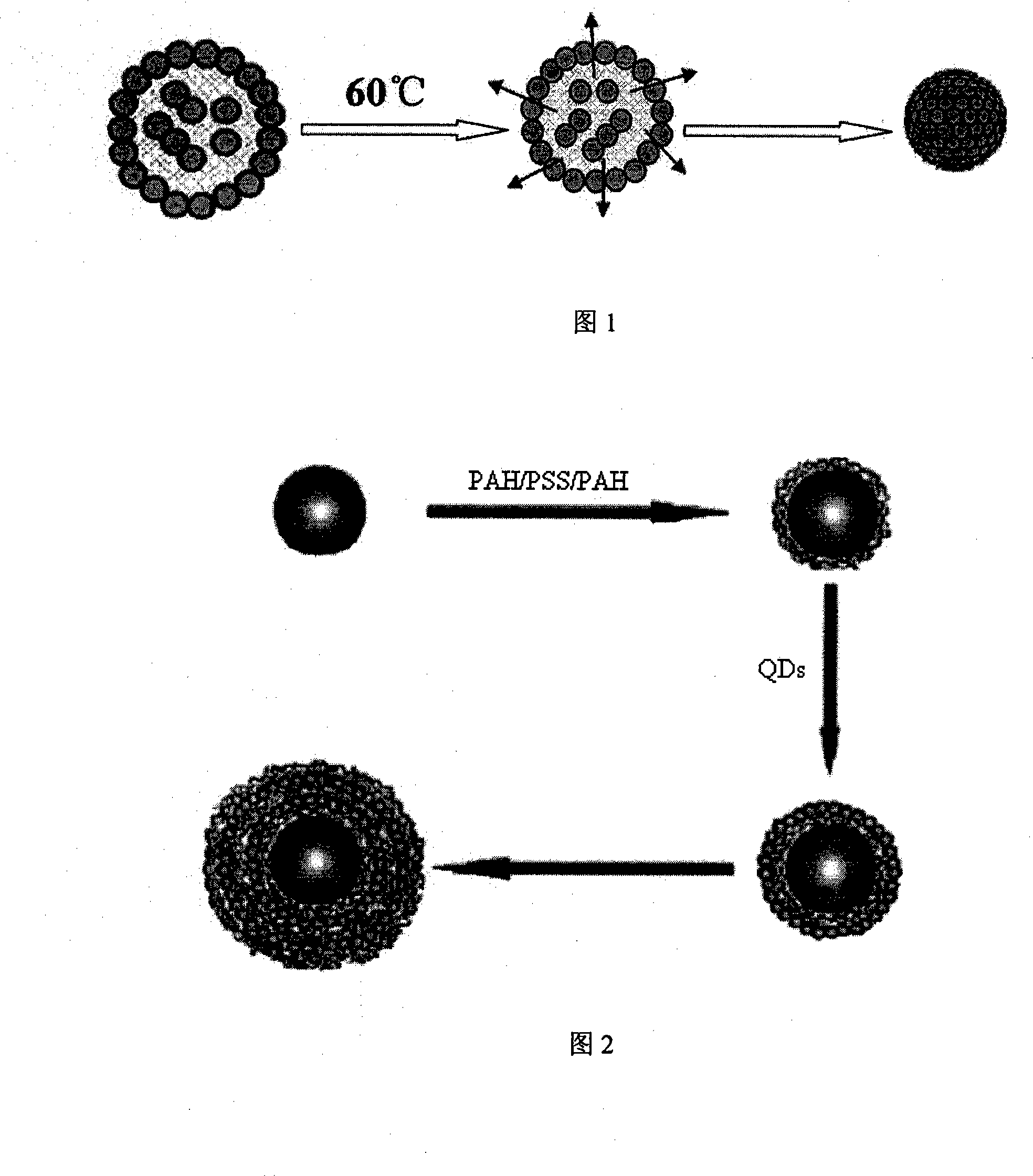Photon crystal composite encoding microsphere and preparation method
A technology of photonic crystal microspheres and photonic crystals, which is applied in the direction of material analysis, measuring devices, instruments, etc. through optical means, can solve the problems of difficult to distinguish emission peaks of emitted light, complex detection equipment, complex preparation, etc., and achieve color adjustable , high photochemical stability and simple preparation method
- Summary
- Abstract
- Description
- Claims
- Application Information
AI Technical Summary
Problems solved by technology
Method used
Image
Examples
preparation example Construction
[0025] The preparation method comprises the following steps:
[0026] Select photonic crystal microspheres with different codes and perform surface treatment on them to obtain negatively charged photonic crystal coded microspheres;
[0027] Using the layer-by-layer adsorption method, the positive polyelectrolyte is first adsorbed on the surface of the photonic crystal microsphere, then the negative polyelectrolyte is adsorbed, and after the positive polyelectrolyte is adsorbed, the quantum dots with different characteristic emission peaks are adsorbed on the outer surface of the microsphere;
[0028] To adsorb quantum dots with different layers or different sizes, the layers are separated by three layers of polyelectrolyte;
[0029] The quantum dots on the outermost layer continue to adsorb four layers of polyelectrolytes for easy detection.
[0030] At the same time, quantum dots of the same type but different sizes are used to mark the substance to be detected, and the conc...
Embodiment 1
[0031] Embodiment one. Preparation of water-soluble CdTe-labeled polystyrene microspheres
[0032]1 Select polystyrene microspheres coded at 600nm and 540nm respectively. Since the synthesized polystyrene particles have carboxyl groups, the surface of the prepared microspheres also has negative charges.
[0033] 2 Soak the prepared microspheres in 0.5mol / L NaCl solution of 1mg / mL PAH first, let it stand for adsorption for 20 minutes, and rinse with ultrapure water three times to wash off excess PAH. Then soak the microspheres in 0.5 mol / L NaCl solution of 1 mg / mL PSS, and also stand still for adsorption and centrifugal washing. After another layer of PAH was adsorbed, the microspheres were soaked in thioglycolic acid-modified CdTe 540 (The emission spectrum is at 540nm) in an aqueous solution, let stand for adsorption for 60 minutes, and then centrifuge and wash.
[0034] 3Repeat the above steps. After adsorbing three layers of polyelectrolyte, the second layer of CdTe is ...
Embodiment 2
[0036] Embodiment two. Preparation of water-soluble CdTe-labeled silica microspheres
[0037] 1 Select 400nm, 460nm and 540nm coded silica microspheres respectively, and immerse them in 70% (V / V0) sulfuric acid and 30% hydrogen peroxide solution overnight, so that the surface of the prepared microspheres is negatively charged.
[0038] 2 Soak the prepared microspheres in 0.5mol / L NaCl solution of 1mg / mL PAH first, let it stand for adsorption for 20 minutes, and rinse with ultrapure water three times to wash off excess PAH. Then soak the microspheres in 0.5 mol / L NaCl solution of 1 mg / mL PSS, and also stand still for adsorption and centrifugal washing. After another layer of PAH was adsorbed, the microspheres were soaked in thioglycolic acid-modified CdTe 540 (The emission spectrum is at 540nm) in an aqueous solution, let stand for adsorption for 60 minutes, and then centrifuge and wash.
[0039] 3Repeat the above steps. After adsorbing three layers of polyelectrolyte, the ...
PUM
 Login to View More
Login to View More Abstract
Description
Claims
Application Information
 Login to View More
Login to View More - Generate Ideas
- Intellectual Property
- Life Sciences
- Materials
- Tech Scout
- Unparalleled Data Quality
- Higher Quality Content
- 60% Fewer Hallucinations
Browse by: Latest US Patents, China's latest patents, Technical Efficacy Thesaurus, Application Domain, Technology Topic, Popular Technical Reports.
© 2025 PatSnap. All rights reserved.Legal|Privacy policy|Modern Slavery Act Transparency Statement|Sitemap|About US| Contact US: help@patsnap.com

